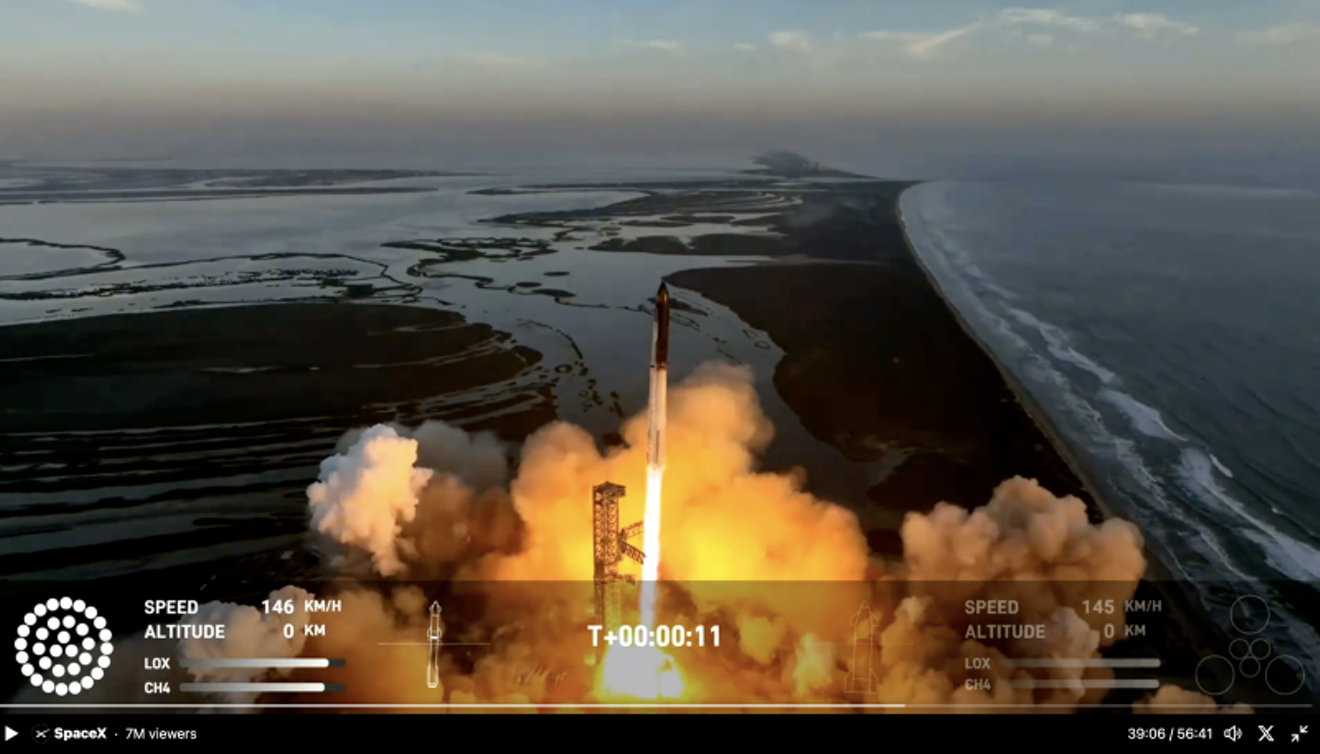Support Us
Houston's independent source of
local news and culture
account
- Welcome,
Insider - Login
- My Account
- My Newsletters
- Contribute
- Contact Us
- Sign out

SpaceX's latest launch
Screenshot
[
{
"name": "Related Stories / Support Us Combo",
"component": "11591218",
"insertPoint": "4",
"requiredCountToDisplay": "4"
},{
"name": "Air - Billboard - Inline Content",
"component": "11591214",
"insertPoint": "2/3",
"requiredCountToDisplay": "7"
},{
"name": "R1 - Beta - Mobile Only",
"component": "12287027",
"insertPoint": "8",
"requiredCountToDisplay": "8"
},{
"name": "Air - MediumRectangle - Inline Content - Mobile Display Size 2",
"component": "11591215",
"insertPoint": "12",
"requiredCountToDisplay": "12"
},{
"name": "Air - MediumRectangle - Inline Content - Mobile Display Size 2",
"component": "11591215",
"insertPoint": "4th",
"startingPoint": "16",
"requiredCountToDisplay": "12"
}
]
On Saturday morning, just shy of seven months after SpaceX’s first Starship test launch exploded midair minutes into flight, the company conducted the second test launch, with mixed results.
On the upside, SpaceX’s mission of flying as much as possible and learning from previous mistakes seems to have paid off.
As of now, it looks like the company managed to launch the rocket without setting fire to the vegetation around its launchpad on the edge of the South Texas Coast, thanks to a newly installed water deluge system that kept dust, debris and flames from flying off the launchpad into the surrounding area when Starship lifts off. Plus, the Federal Aviation Administration received no reports of property damage in the area with this second test launch, although FAA officials are investigating the rocket’s explosion.
The rocket launched a little after 7 a.m. from Starbase, SpaceX’s launch site located just outside of Brownsville, juddering across clear blue sky propelled by all 33 of the Super Heavy booster’s engines. (Last time only 31 managed to light.)
Then the rocket went into the second “hot” stage, described by the SpaceX launch webcast’s commentators as the stage that puts the most stress on the spacecraft—and the point when the previous test rocket exploded before completing the separation.
This time around the spacecraft once again began flipping through the air to start the process of separating from the Super Heavy booster and lighting the six engines in the upper stage that would propel the spacecraft into space. At just under three minutes, Starship completed the process with a flash showing that the Super Heavy had been disconnected, while the crowd watching the launch from SpaceX headquarters in Hawthorne, California could be heard vigorously celebrating on the webcast video.
From there, the booster was supposed to drop down into the Gulf of Mexico, but roughly 30 seconds after completing stage two there was another flash as the Super Heavy became a ball of flames midair.
However, the spacecraft was still aloft, the commentators noted. If it had continued on its flight, Starship would have traveled halfway around the world before plunking into the Pacific Ocean just a couple hundred miles from Hawaii. But that didn’t happen. Although Starship reached an altitude of 90 miles as it headed toward orbit, SpaceX lost contact with the vehicle which was intentionally destroyed via its flight detonation system.
So, yeah, once again SpaceX has got another blown up rocket for its efforts, but they got a lot farther – 90 miles up, to be exact – than they did before. The company is contracted with NASA to tote astronauts to the moon for the first mission to the lunar southern poles in 2025 (already expected to be pushed to 2026) and the second crewed landing, scheduled for 2028. NASA officials have said they will require SpaceX to complete just under 20 launches before Starship heads from the earth to the moon. Let’s hope some of them don’t blow up.
KEEP THE HOUSTON PRESS FREE...
Since we started the Houston Press, it has been defined as the free, independent voice of Houston, and we'd like to keep it that way. With local media under siege, it's more important than ever for us to rally support behind funding our local journalism. You can help by participating in our "I Support" program, allowing us to keep offering readers access to our incisive coverage of local news, food and culture with no paywalls.
Dianna Wray is a nationally award-winning journalist. Born and raised in Houston, she writes about everything from NASA to oil to horse races.
Contact:
Dianna Wray
Trending News
- Librarians Under Siege in Montgomery County?
- Four Wishes for the Houston Texans 2024 Schedule
- Dan Patrick Sets Off Alarm Bells For Public School Advocates With His Property Tax Trial Balloon
-
Sponsored Content From: [%sponsoredBy%]
[%title%]

Don't Miss Out
SIGN UP for the latest
news, free stuff and more!
Become a member to support the independent voice of Houston
and help keep the future of the Houston Press FREE
Use of this website constitutes acceptance of our
terms of use,
our cookies policy, and our
privacy policy
The Houston Press may earn a portion of sales from products & services purchased through links on our site from our
affiliate partners.
©2024
Houston Press, LP. All rights reserved.





